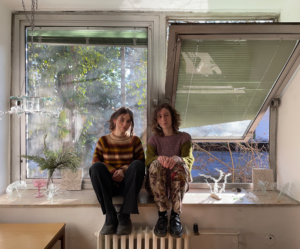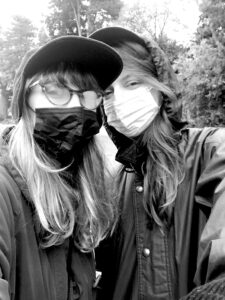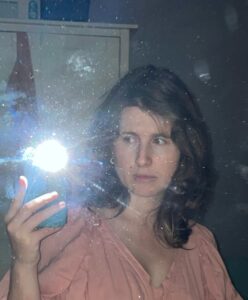Timea Oravecz
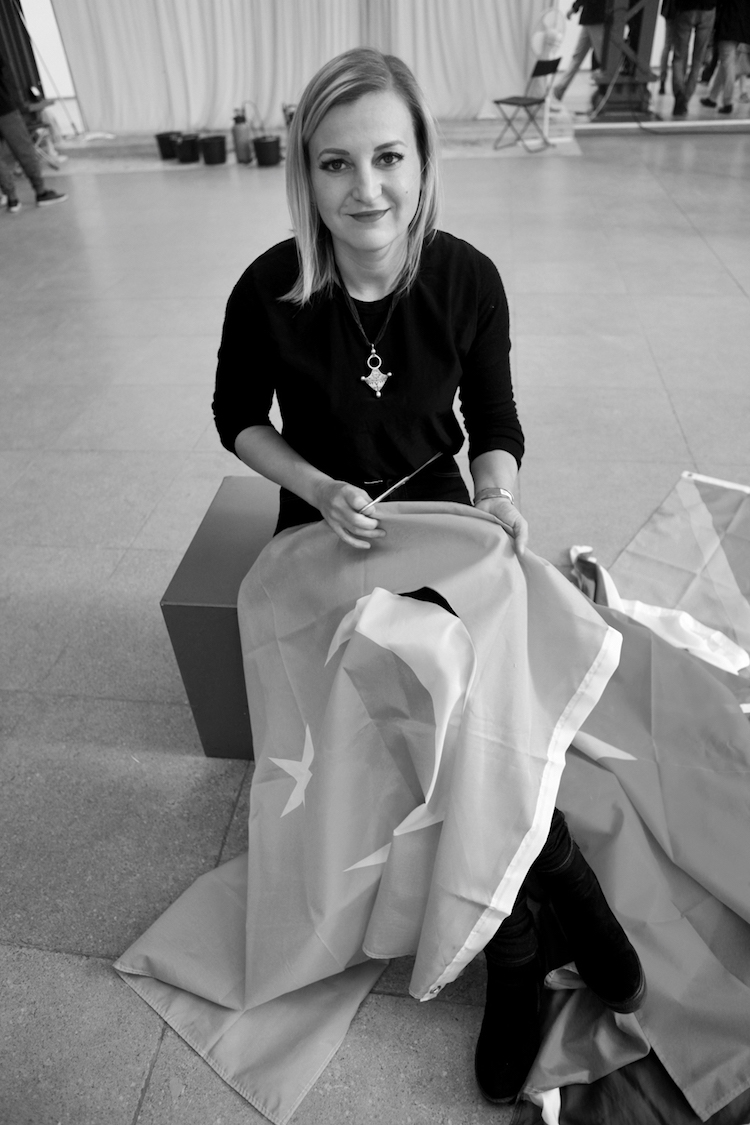
– born in 1975, Budapest, currently lives and works in Berlin. She is a graduate of Department of Sculpture at Accademia di Belle Arti, Venice and Institut für Raumexperimente in Berlin. Combining her background and the experiences faced as an immigrant, she developed a practice that focuses on the relationship between personal identity, culture of origin and need for integration. Her projects are usually connected to the socio-cultural context she lives in and are inspired by daily life. The experience of the urban space and its connections between the political, cultural and historical context is crucial for her work.
Portrait of the artist by Petra Fantozzi.
For more than twenty years, I have been living in different West European countries, being fascinated by cultural and social approaches that differed radically from those I experienced during my childhood in Hungary, under the socialist regime.
I started my studies at the Academy of Fine Arts Vienna in 1998. Later on, I attended art schools in several other countries (Italy, Spain, Germany) enrolling either as a student or as what I would call a “long-term tourist”. During my “Vienna years”, Hungary had not yet joined the European Union, which made my stay strenuous, both administratively and financially. During my wanderings, my native country became part of united Europe, theoretically ensuring the free flow of people and labour. Despite this, acquiring the documents needed for a legal stay in the EU remained a demanding and time-consuming process, often generating absurd moments or simply unfulfillable requirements1.
As a former immigrant, I approach the phenomenon of migration from an emotional point of view by tracing a map of difficulties and states of mind that occur in everyday life. The importance of urban space became essential in my work. Examining the relation between political, cultural, and architectural contexts – and especially the modern architecture of the 70s and 80s in the suburbs of Budapest, that I later compared to the suburbs of other Eastern and Central European countries – became my deep study about “real life” of people living in the socialist era and an autobiography at the same time.
Socreality2 was an earlier piece, and later, it also became the title of my final thesis for the Academy of Fine Arts in Venice. The video was made using the motif of Western “reality shows” but ironically, my “reality show” was made in Hungary in the 80s and mid-90s. I wanted to show everyday life during communism, showing the real life of people within the Socialistic Regime. My will to do so appeared when I lived in Austria, Spain, and Italy, as everyone asked me about those times. The people born in a western context thought that socialism was something good (especially in Italy where communism was fighting back against fascism); people often thought that it was something super romantic, that it was nice that everyone had the same possibilities. I always told them that indeed, everyone had more or less the same possibilities, but everyone was poor. I used recorded pieces from TV daily news and propagandist films from the Hungarian film archive. They showed how “good communist people” should live their lives. They presented happy families in block-houses; happy pioneers at the school. They were a lie that we should’ve desired. I used those archival videos and inserted my personal childhood photos into them. Not realizing this beforehand, I discovered that the life of my family perfectly corresponded to the model of a typical socialist family3.
The series Time Lost45 from 2007 presents administrative documents acquired during a period of nine years (residence permits, visas, passport stamps) in embroidered patterns. I did my very best to painstakingly jump through all the bureaucratic hoops, and to illustrate this I embroidered every tiny letter, code, stamp, and signature on these forms, even if the task proved to be time-consuming, senseless, or sometimes simply undoable—I also occasionally hurt myself with the needle6.
The same subject reappears in the video installation Cosmopolitan, 20097 comprising films in three different languages (Hungarian, Italian, and German), and in which I relate the absurd difficulties of changing my residence from one country to another. I dispassionately list the kind of detours that self-contradictory regulations within the EU have compelled me to take. As my experience shows, some sort of productivist bias creates a situation in which the free movement of workers is conveniently regulated only for those who toil in the economy at large, while the endeavours of an emerging visual artist fall outside this category. In exhibition situations, the screens of Cosmopolitan are installed in such a way that the sounds of the simultaneously running monotonous narratives converge into a cacophony, conveying a feeling of befuddlement over the discrepancy between the proclaimed liberty of EU citizens and the artist’s own frustrating experience8.
When in 2015, the current Hungarian government built a huge wall on the border between Hungary and Serbia to keep migrants out, my anger inspired me to create Welcome to the EU, 2016910. I also realized two more wall installations on this topic, Windless, Variations for the EU Flag Nr. 1, 201611 with multi-coloured kitchen knives that create a fierce circle, and its variation entitled Windless. Variations for the EU Flag Nr. 2, 201612, in which I ironically composed a circle made from Japanese shuriken, star-shaped weapons that are thrown to kill.
My most recent work Fragile Juncture, 20201314 is a work that encompasses pressing issues concerning the European Union, Brexit, the Corona Crisis as well as the growing right-wing/anti-EU movements and Nationalism within the EU — all of which are creating troubling situations and fragile junctures in the socio-historic condition of the European Union. The EU thus faces its greatest challenges and needs to find solutions before this union of nation-states collapses entirely. I was frightened and very worried when I found pictures of protests against EU membership, EU politics, refugees, and foreigners in general during my research on Google, which I found in all 27 EU member states. Following this, I selected pictures of these anti-EU demonstrations, sorted them by country, and drew them on a large canvas (250 x 230 cm) with graphite pencil. All of them together created a large map of Europe. Then, I cut the canvas in such a way that the neighbouring countries are only held together by a loose, thin sewing thread. With this work I want to point out that this is a very fragile, historical moment in which we all have to fight against the deliberate nationalistic and right-wing extremist waves of politicians in order to preserve the values of the European Community together15.
The Site-specific installation at Neue Nationalgalerie in Berlin entitled Stairway to heaven, 201416 was inspired by beliefs ingrained in Hungarian culture. The installation consists of an 8,5-meter-long rope-ladder hanging between two circle-shaped mirrors placed on the roof and the ceiling.
According to certain theories, the ancient Hungarian religion was a form of Tengriism. Tengriism is a shamanistic religion, which was common in the early Turkic, Uralic, and Mongol communities. The central symbol of the shamanistic cosmology is the World Tree, which connects heaven and the underworld to our earthly world. Shamans were travellers between these three spheres and intermediaries between worlds, thereby acting as spiritual leaders for their communities. From the beginning of humanity, this function was filled by the shamans, but they do not exist anymore in Europe, and the structure of these societies have changed.
Artists often ask themselves how they can be useful today for society. I believe that the role of the shamans should be filled by the artists today and they should liberate the people from their everyday life and bring them unknown parallel dimensions. I understand that maybe that kind of journey could be a solution for contemporary people in their everyday material lives – giving them a kind of freedom or just something to believe in17.
In the frame of Per Aspera ad Astra, 201718 – an artistic intervention I made at the Hamburger Bahnhof in Berlin, I cut out the astral symbols — the iconic stars, planets, and suns — from several national flags and release them back into the sky, sending them off with balloons to where they belong. This gesture liberates the symbols from any political use or connotation. Only the artist or modern Shaman, per the artist’s argument, driven by utopian ambition and under a state of non-belonging, is able to overturn conventions and constraints to convey new visions that transcend political and economic models.
The performance is an open-minded invitation and search for yet un-thought solutions to gaining global harmony and happier life on earth. I’m convinced that artists are able to influence or change public opinion, influence political decisions, and make invisible things visible by using their magic instrument called ART.
The statement was written in collaboration with Magdalena Adameczek (2020).
1Francesca Boenzi and Beata Hock, Nomad Stories Timea Anita Oravecz, publ. Goldrausch Künstlerinnen Projekt ART IT, Berlin, 2012, see: http://www.timeaoravecz.com/neu/files/oravecz_nomad%20stories.pdf2Image: Timea Oravecz, Socreality, 2003, video, color, sound, 4‘20’’. Courtesy of the artist.
3Laurel McLaughlin, The freedom of moving through borders, 2015, Slought Foundation, Philadelphia, see: https://slought.org/blog_posts/the_freedom_of_moving_through_borders
4Image: Timea Oravecz, Time Lost Nr.IV., 2016, hand embroidery on fabric, textil, colored filet sillk, 70 x 60 cm, Zachęta – National Gallery of Art, Warsaw, photo Marek Krzyżanek. Courtesy of the artist.
5Image: Timea Oravecz, Time Lost Nr.IV., (detail), 2016, hand embroidery on fabric, textil, colored filet sillk, 70 x 60 cm, Zachęta National Gallery of Art, Warsaw, photo Timea Oravecz. Courtesy of the artist.
6Beata Hock, Agency Gendered: Deconstructed Marriages and Migration Narratives in Contemporary Art, Leipzig, 2011
7Image: Timea Oravecz, Cosmopolitan, 2009, video installation, 6’30’’ each, languages: Italian, German, Hungarian, Hartware MedienKunstVerein, Dortmund, photo Thomas Wucherpfennig. Courtesy of the artist.
8Beata Hock, Agency Gendered: Deconstructed Marriages and Migration Narratives in Contemporary Art, Leipzig, 2011
9Image: Timea Oravecz, Welcome to the EU, 2016, sculpture, 115 x 153 x 100 cm, welded iron, 7th Art Biennial, Serbia, photo Vladimir Pavic. Courtesy of the artist.
10Image: Timea Oravecz, Welcome to the EU, 2016, sketch, 21 x 29 cm, drawing on paper. Courtesy of the artist.
11Image: Timea Oravecz, Windless, Variations for the Eu Flag Nr.1., 2016, installation, 300 x 200 cm, wall painting, colour Pantone Reflex Blue, RGB: 0/51/153; 12 kitchen knives, 17th Art Biennial, Serbia, photo Vladimir Pavic. Courtesy of the artist.
12Image: Timea Oravecz, Windless, Variations for the Eu Flag Nr.2., 2016, installation, 300 x 200 cm, wall painting, colour Pantone Reflex Blue, RGB: 0/51/153; 12 shurikens, 17th Art Biennial, Serbia, photo Vladimir Pavic. Courtesy of the artist.
13Image: Timea Oravecz, Fragile Juncture, 2020, drawing and hand embroidery on canvas, 250 x 230 cm, Berlin, photo Timea Anita Oravecz. Courtesy of the artist.
14Image: Timea Oravecz, Fragile Juncture (detail), 2020, drawing and hand embroidery on canvas, 250 x 230 cm, Berlin, photo Timea Anita Oravecz. Courtesy of the artist.
15Julia Hartmann, Network Sphere by KARA AGORA Art & Research Center, Vienna, 2020, see: http://www.karaagora.center/wp-content/uploads/2020/09/Booklet_Net-Works-3.pdf
16Image: Timea Oravecz, Stairway to heaven, 2014, site-specific installation, rope-ladder: 850 x 70 x 4 cm, two high-polished metal sheets, Neue Nationalgalerie, Berlin, photo Balint Meggyesi. Courtesy of the artist.
17Laurel McLaughlin, The freedom of moving through borders, 2015, Slought Foundation, Philadelphia, see: https://slought.org/blog_posts/the_freedom_of_moving_through_borders
18Image: Timea Oravecz, Per Aspera ad Astra, 2017, installation and performance, flags, balloons, Hamburger Bahnhof Museum of Contemporary Art, Berlin, photo Petra Fantozzi. Courtesy of the artist.
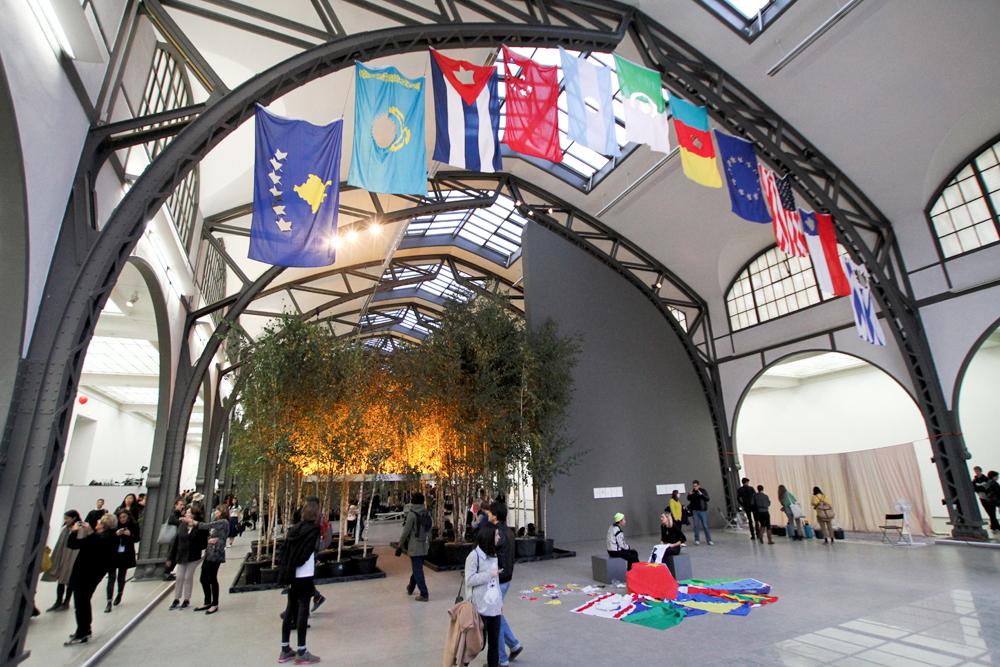
– szül. 1975, Budapest – jelenleg Berlinben él és dolgozik. A velencei Accademia di Belle Arti és a berlini Institut für Raumexperimente szobrászati tanszékén végzett. Saját hátterére és a bevándorlóként megélt tapasztalatokra támaszkodva dolgozta ki művészeti praxisát, amely a személyes identitás, a származási ország kultúrája és az integráció iránti igény kapcsolatára összpontosít. Projektjei általában ahhoz a társadalmi-kulturális kontextushoz kapcsolódnak, amiben él, és a mindennapi élet ihleti őket. A városi tér tapasztalata és annak politikai, kulturális és történelmi összefüggései közötti kapcsolatok kulcsfontosságúak munkája szempontjából.
A művész portréját készítette: Petra Fantozzi.
Több mint húsz éve élek különböző nyugat-európai országokban, teljesen megbabonázva az ottani kulturális és társadalmi szemléletmódoktól, amelyek nagyon különböztek attól, amit gyerekkoromban Magyarországon tapasztaltam a szocialista rendszer alatt.
1998-ban kezdtem tanulmányaimat a Bécsi Képzőművészeti Akadémián. Később számos más országban (Olaszország, Spanyolország, Németország) jártam művészeti iskolákba, vagy hallgatóként, vagy ahogyan én szoktam nevezni „hosszútávú turistaként”. A „bécsi éveim alatt” Magyarország még nem csatlakozott az Európai Unióhoz, ami adminisztratív és pénzügyi szempontból is megterhelővé tette tartózkodásomat. A művészeti barangolások ideje alatt szülőföldem az egyesült Európa részévé vált, elméletileg biztosítva az emberek és a munkaerő szabad áramlását. Ennek ellenére az EU-ban való legális tartózkodáshoz szükséges dokumentumok megszerzése továbbra is megerőltető és időigényes folyamat volt, gyakran abszurd pillanatokat vagy egyértelműen teljesíthetetlen követelményeket támasztva1.
Mint volt bevándorló érzelmi szempontból közelítem meg a migrációs jelenséget, a mindennapi életben előforduló nehézségek és lelkiállapotok térképének megjelenítésével. Munkám során elengedhetetlenné vált a városi tér. A politikai, kulturális és építészeti összefüggések vizsgálata – és különösen a 70-es, 80-as évek, a modernkori Budapest külvárosi építészetének tanulmányozása, amelyet később összehasonlítottam a többi kelet- és közép-európai ország külvárosával – a szocialista korszak társadalmának „valódi életéről” szóló részletes kutatássá és egyszerre egy önéletrajzzá is vált.
A Socreality2 egy korábbi mű, ami később a velencei Képzőművészeti Akadémián írt záródolgozatom címe is lett. A videó a nyugati “valóságshow-k” motívumára épült; de ironikus módon az én “valóságshowm” Magyarországon készült az 1980-as években és az 1990-es évek közepén. Meg akartam mutatni a mindennapokat a kommunizmus idején, bemutatva az emberek valódi életét a szocialista rendszerben. Azóta vágytam erre, amióta Ausztriában, Spanyolországban és Olaszországban éltem, és ott mindenki ezekről az időkről kérdezgetett. A nyugaton születettek úgy gondolták, hogy a szocializmus valami jó dolog (különösen Olaszországban, ahol a kommunizmus a fasizmussal szemben határozta meg magát); az emberek sokszor gondolták, hogy ez valami szuper romantikus dolog, hogy jó, hogy mindenki ugyanazokkal a lehetőségekkel rendelkezik. Mindig mondtam nekik, hogy valóban mindenkinek többé-kevésbé ugyanazok a lehetőségei voltak, de közben mindenki szegény is volt. Felhasználtam a tévéből felvett napi híradók részleteit és a magyar filmarchívum propagandista filmjeit. Arról szóltak, hogy a “jó kommunista embereknek” hogyan kell élniük az életüket. Panelházakban élő boldog családokat mutattak be; boldog úttörőket az iskolában. Olyan valótlanságot közvetített, amelyre egyébként vágytunk volna. Ezekbe az archív videókba illesztettem be a saját személyes fotóimat. Rájöttem, hogy a családom élete tökéletesen megfelelt egy tipikus szocialista család modelljének, anélkül, hogy ezt korábban észrevettem volna3.
A 2007-ben készült Time Lost45 sorozat kilenc év alatt összegyűjtött adminisztrációs dokumentumokat (tartózkodási engedélyek, vízumok, útlevélbélyegek) mutat be hímzett mintákon keresztül. Mindent megtettem azért, hogy lelkiismeretesen átküzdjem magam az összes bürokratikus akadályon, és ennek szemléltetésére minden apró betűt, kódot, bélyeget és aláírást ráhímeztem ezekre a nyomtatványokra, még akkor is, ha a feladat időigényesnek, értelmetlennek vagy olykor egyszerűen megmásíthatatlannak bizonyult – és még ha időnként meg is sértettem magam a tűvel6.
Ugyanez a téma felmerült a Cosmopolitan7, 2009 című videoinstallációban, ahol a három különböző nyelven (magyarul, olaszul és németül) bemutatott filmek abszurd nehézségeket mutatnak be, amikor lakhelyemet egyik országról a másikra változtattam. Érzelemmentesen felsorolom azokat a kitérőket, amelyekre az EU-n belüli önellentmondó szabályozások kényszerítettek. Tapasztalataim szerint, az úgynevezett produktivista elfogultság olyan helyzetet teremt, amelyben a munkavállalók szabad mozgásának szabályozása csak azok számára kényelmes, akik a világgazdaságért gürcölnek, míg egy feltörekvő képzőművész ambíciói kívül esnek ezen a kategórián. Kiállítások során a Cosmopolitan képernyőit úgy installálom, hogy az egyszerre futó monoton elbeszélések hangjai kakofóniává olvadjanak össze, ami szimbolizálja az uniós polgárok kikiáltott szabadsága és a művész saját frusztráló tapasztalata közötti eltérést8.
Amikor a jelenlegi magyar kormány 2015-ben Magyarország és Szerbia határán felhúzott egy hatalmas falat, hogy távol tartsa a migránsokat, az ezzel kapcsolatos dühöm inspirált arra, hogy megalkossam a Welcome to the EU910, 2016 című művem. Két másik fal installáció készült erre a témára, a Windless, Variations for the EU Flag Nr. 111, 2016, amelyben színes konyhakések alkotnak egy indulatos kört, és ennek variációja, a Windless, Variations for the EU Flag Nr. 212, 2016, amelyben japán shurikenekből, halálos dobócsillagokból alkottam ironikusan egy kört.
Legfrissebb munkám, a Fragile Juncture1314, 2020 egy olyan mű, amely az Európai Uniót, a Brexitet, a COVID-19 válságot, valamint az egyre növekvő jobboldali, EU-ellenes mozgalmakat és az EU-n belüli nacionalizmust érintő sürgető kérdéseket öleli fel. Mindez aggasztó és törékeny helyzeteket teremt az Európai Unió társadalmi és történeti kontextusában. Az EU-nak tehát a legnagyobb kihívásokkal kell szembenéznie, és megoldásokat kell találnia, mielőtt a nemzetállamok uniója teljesen összeomlik. Meg voltam rémülve, amikor a Google-n végzett kutatásaim során mind a huszonhét EU tagállamban készült képeket találtam az EU-tagság, az EU-politika, a menekültek és általában a külföldiek elleni tiltakozásokról. Ezt követően kiválasztottam néhány képet ezekről az EU-ellenes tüntetésekről, országok szerint rendeztem, és grafitceruzával egy nagy vászonra (250 cm x 230 cm) rajzoltam, amely együtt egy nagy Európa térképet adott ki. Ezután szétvágtam a vásznat úgy, hogy a szomszédos országokat csak egy laza, vékony varrócérna fogja össze. Ezzel a munkával szeretnék rámutatni, hogy ez egy nagyon törékeny, történelmi pillanat, amelyben mindannyiunknak meg kell küzdenünk a politikusok szándékos nacionalista és jobboldali szélsőséges ideológiájával annak érdekében, hogy együtt megőrizzük az Európai Közösség értékeit15.
A berlini Neue Nationalgalerie-ben található helyspecifikus installációt, a Stairway to Heaven-t16, 2014, a magyar kultúrában meghonosodott hiedelmek ihlették. Az installáció egy 8,5 méter hosszú kötéllétrából áll, amely a tetőre és a mennyezetre helyezett két kör alakú tükör között lóg.
Bizonyos elméletek szerint az ősi magyar vallás a tengrizmus egyik formája volt. A tengrizmus egy sámánista vallás, amely a korai török, uráli és mongol közösségekben volt megszokott. A sámánista kozmológia központi szimbóluma a Világfa, amely összeköti az eget és az alvilágot földi világunkkal. A sámánok utazók voltak e három szféra között, közvetítők a világok között, és ezáltal a közösségek szellemi vezetői is. Az emberiség kezdetétől ezt a funkciót a sámánok töltötték be, de ez Európában már nem áll fenn, és ezeknek a társadalmaknak a szerkezete is megváltozott.
A művészek gyakran felteszik maguknak a kérdést, hogy miként lehetnek ma hasznosak a társadalom számára. Úgy gondolom, hogy a sámánok szerepét ma a művészeknek kell betölteniük, és fel kell szabadítaniuk az embereket a mindennapi életüktől, és ismeretlen párhuzamos dimenziókat létrehozni számukra. Ez a fajta út talán megoldást jelenthet az emberek számára a mindennapi materialista életükben – adni nekik valamiféle szabadságot vagy csak valamit, amiben hihetnek17.
Egy művészeti akciómban, a Per Aspera ad Astra18, című (2017), a berlini Hamburger Bahnhofban bemutatott munkámban több nemzeti lobogóból égi szimbólumokat – az ikonikus csillagokat, bolygókat, a Napot – vágtam ki és visszaengedtem őket az égre, lufikkal küldve őket oda vissza, ahová tartoznak. Ez a gesztus felszabadítja a szimbólumokat minden politikai felhasználástól vagy konnotációtól. Csak a művész vagy modern sámán, a művész érvelése szerint, utópisztikus ambícióktól vezérelve és a sehová sem tartozás állapotában képes megdönteni a konvenciókat és a kényszereket, hogy új elképzeléseket közvetítsen, amelyek meghaladják a politikai és gazdasági modelleket.
A performansz egy előítéletektől mentes meghívás és a még fel nem fedezett megoldások után való keresgélés a globális harmónia és boldogabb élet eléréséhez a Földön. Meggyőződésem, hogy a művészek a művészet nevű mágikus eszközükkel képesek hatást gyakorolni vagy akár megváltoztatni a közvéleményt, befolyásolni a politikai döntéseket és láthatóvá tenni a láthatatlan dolgokat.
A statement Oravecz Tímea Anita és Magdalena Adameczek kurátorral együttműködésében jött létre (2020).
1Francesca Boenzi és Hock Beáta: Nomad Stories Tímea Anita Oravecz, kiadta a Goldrausch Künstlerinnen Projekt ART IT, Berlin, 2012. Lásd: http://www.timeaoravecz.com/neu/files/oravecz_nomad%20stories.pdf2Kép: Oravecz Tímea, Socreality, 2003, videó, szín, hang, 4‘20’’. A művész jóvoltából.
3Laurel McLaughlin, The freedom of moving through borders, 2015, Slought Foundation, Philadelphia. Lásd: https://slought.org/blog_posts/the_freedom_of_moving_through_borders
4Kép: Oravecz Tímea, Time Lost Nr.IV., 2016, kézi hímzés anyagon, textil, színes hímzőselyem, 70 x 60 cm, Zachęta – Nemzeti Művészeti Galéria, Varsó. Fotó Marek Krzyżanek. A művész jóvoltából.
5Kép: Oravecz Tímea, Time Lost Nr.IV., (részlet), 2016, kézi hímzés anyagon, textil, színes hímzőselyem, 70 x 60 cm, Zachęta – Nemzeti Művészeti Galéria, Varsó. Fotó: Oravecz Tímea Anita. A művész jóvoltából.
6Hock Beáta, Agency Gendered: Deconstructed Marriages and Migration Narratives in Contemporary Art, Lipcse, 2011
7Kép: Oravecz Tímea, Cosmopolitan, 2009, videó installáció, 6’30’’ egyenként, olasz, német és magyar nyelven, Hartware MedienKunstVerein, Dortmund. Fotó Thomas Wucherpfennig. A művész jóvoltából.
8Hock Beáta, Agency Gendered: Deconstructed Marriages and Migration Narratives in Contemporary Art, Lipcse, 2011
9Kép: Oravecz Tímea, Welcome to the EU, 2016, szobor, 115 x 153 x 100 cm, hegesztett vas, 7th Art Biennial, Szerbia. Fotó Vladimir Pavić. A művész jóvoltából.
10Kép: Oravecz Tímea, Welcome to the EU, 2016, vázlat, 21 x 29 cm, rajz papíron. A művész jóvoltából.
11Kép: Oravecz Tímea, Windless, Variations for the Eu Flag Nr.1., 2016, installáció, 300x200 cm, falfestmény, szín: Pantone Reflex Blue, RGB: 0/51/153; 12 db konyhakés, 17th Art Biennial, Szerbia. Fotó Vladimir Pavić. A művész jóvoltából.
12Kép: Oravecz Tímea, Windless, Variations for the Eu Flag Nr.2., 2016, installáció, 300 x 200 cm, wall falfestmény, szín: Pantone Reflex Blue , RGB: 0/51/153; 12 dobócsillag, 17th Art Biennial, Szerbia. Fotó Vladimir Pavić. A művész jóvoltából.
13Kép: Oravecz Tímea, Fragile Juncture, 2020, rajz és kézi hímzés vásznon, 250 x 230 cm, Berlin. Fotó: Oravecz Tímea Anita. A művész jóvoltából.
14Kép: Oravecz Tímea, Fragile Juncture (részlet), 2020, rajz és kézi hímzés vásznon, 250 x 230 cm, Berlin. Fotó Oravecz Tímea Anita. A művész jóvoltából.
15Julia Hartmann, Network Sphere by KARA AGORA Art & Research Center, Bécs, 2020. Lásd: http://www.karaagora.center/wp-content/uploads/2020/09/Booklet_Net-Works-3.pdf
16kép: Oravecz Tímea, Stairway to heaven, 2014, helyspecifikus installáció, kötéllétra: 850 x 70 x 4 cm, két polírozott fémlap, Neue Nationalgalerie, Berlin. Fotó Meggyesi Bálint. A művész jóvoltából.
17 Laurel McLaughlin, The freedom of moving through borders, 2015, Slought Foundation, Philadelphia. Lásd: https://slought.org/blog_posts/the_freedom_of_moving_through_borders
18Kép: Oravecz Tímea, Per Aspera ad Astra, 2017, installáció és performansz, zászlók, léggömb, Hamburger Bahnhof Museum of Contemporary Art, Berlin. Fotó Petra Fantozzi. A művész jóvoltából.

